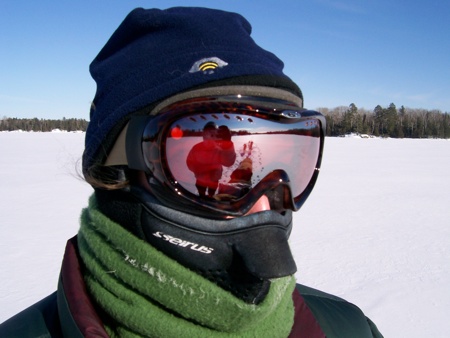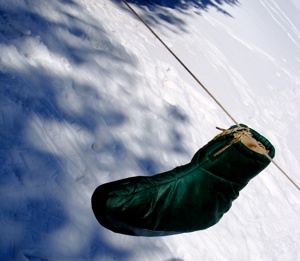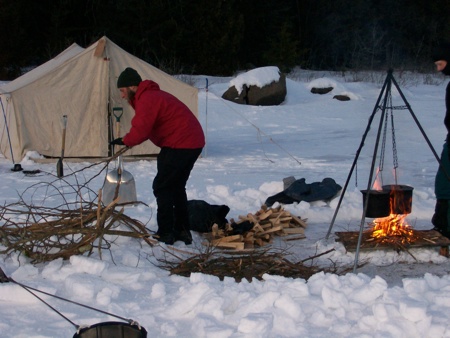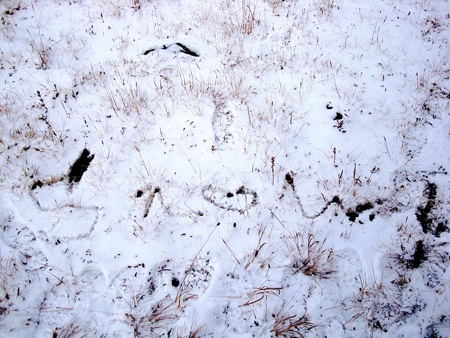Only go outside and travel if you need to do so.
- If you need to travel, plan to manage the hazards of events that you hope will not occur.
- For example:
- Are you dressed well enough to stay warm if you miss the bus to work or school?
- Do you have an emergency kit in your car (extra clothes, blanket or sleeping bag, flares, snacks, water, etc.) so you can survive a mechanical problem while on a less traveled or remote section of road?
- Do you have extra gloves, sunglasses, and clothing should you lose them while traveling (snowshoeing, skiing, etc.) in the backcountry?
- Do you have shelter, a sleeping bag, and sleeping pad to insulate yourself from the ground in the event that you must spend an unexpected night out?
- Do other people know where you are going and when to expect you back?
- Do you have a way to communicate in case you have a problem? (e.g. cell phone with charged battery and good reception, GPS messaging device, satellite telephone, etc.)
Regardless of the environment or setting, in an emergency, those with a plan have the greatest likelihood of success, and the consequences of not succeeding in an extreme cold environment can be very serious.
Dress in loose, non-cotton layers so you can moderate your heat retention and heat loss, and wear a layer that protects you from heat loss due to the wind.
- The layering principle is crucial to all outdoor expeditions, especially during the winter. This principle allows one to shed a layer of clothing when hot and add one when cold. Ideally, you will not sweat or shiver when following this technique properly. Layers should be easily accessible while in the backcountry. This principal includes your hands, as your hands will warm up while traveling and quickly cool when stopped.
- Loose layers will help prevent constrictions and will more easily allow warm blood to flow from the body’s warm core to the extremities. Loose layers will also help trap heat that your body has generated.
- A warm body core will allow the brain to send warm blood more readily to the extremities, like the fingers and toes. If your core is cold, your fingers and toes will be cold.
- NO Cotton –While cotton is a good insulator when it’s DRY, once it becomes damp or wet, its insulating value is dramatically decreased. On winter expeditions, it is essential to keep your body temperature up throughout the day and night. Whether through sweat or immersed in water, once cotton is wet, it will compromise your body temperature and will potentially create a hypothermic situation. Other natural fibers like wool and silk, or synthetic materials, maintain a higher insulating value even when wet, and they also dry more quickly.
- Without protection from the wind any heat that your body has generated will be quickly blown away. Having a jacket with a well fitting collar and wearing a scarf or neck gaiter will help trap heat in your loose layers, preventing it from escaping like heat out of a chimney.
- You can also pull your scarf over your nose and mouth. This will allow a warm, moist layer of air to collect in front of your nose and mouth and begin to pre-warm the cold air before it enters your lungs.
- Wear a hat that covers your ears or have a jacket with a hood. While one does not lose disproportionately more heat from the head and neck than similar amounts of exposed skin, the head and neck represent approximately 9% of the body’s total surface area for an adult and as much as 18-20% for a child or infant. The head and neck contain many blood vessels close to the surface and heat can easily be lost.

Photo by Terri Latimer.
- The ears, cheeks, and tip of the nose are also prime candidates for cold injuries (especially when it’s windy), and along with any other exposed areas of the skin, should be protected and frequently checked for signs of cold injury (white or waxy looking areas).
Stay Dry!
- If you are exerting yourself, do not do so to the point of heavy sweating.
- Adjust your clothing layers to allow for the proper temperature regulation so you can stay warm without over sweating. Take the time to do things like add or remove layers, pull up your sleeves, open the zippers of your jacket, or remove your hat. Do not wait until your clothing layers are soaked with sweat to deicide to remove some of them.
- Sweaty layers will quickly freeze and snow that has accumulated on your clothes will then melt when brought near your warm body, making your clothes wet. Whenever possible brush snow from your outer clothing.
- Your skin will be quickly cooled by the evaporation of sweat on exposed areas. Our bodies cool significantly more rapidly when wet than when dry. Do your best to keep all your clothes dry by not putting gloves, mittens, your hat or other clothes down on the snow.

Photo by Alex Gorosh.
- Do not wait until your hands and feet are cold or you “get a chill,” before you add clothing layers. While certain natural fibers and synthetic materials insulate better than cotton clothing when wet, dry clothing is always warmer. Wet clothing and exposed wet hair quickly freeze when exposed to extreme temperatures.
- Do not sit directly on the snow or on cold ground; no matter how warm you may feel. In addition to losing heat directly to the ground via conduction, your warm body will melt the snow getting your clothes wet. Always sit on something (backpack, sleeping pad, climbing rope, etc.) which will insulate your body from the cold ground and help reduce your contact with snow.
- Keep your sleeping bag dry and have a dry pair of socks reserved only for sleeping. Do not go to bed wearing wet socks. Before bedtime check your feet for signs of cold injury.
- Go to bed warm (do a little light exercise, without sweating), use a hot water bottle in your sleeping bag to assist in drying damp layers, and have a snack before you go to sleep.
Eat, Eat, Eat!
- Bring On The Fat! – In the winter, it is best to eat a high calorie diet as well and a little extra fat. Without calories from high-energy foods like cheese, butter, nuts, peanut butter, and quick burning sugary foods like chocolate, candy and granola, the body can’t exercise and generate heat. Depending on the temperature, you can consume approximately 3,000 calories or more per day (the colder the temperature, the higher the caloric intake). Meats such as pepperoni, sausage and bacon keep the internal furnace burning and unlike summer expeditions, they don’t spoil due to the outside temperature! A winter trip in a cold, remote environment is not the time or place to, “go on a diet” and try to lose weight.
- Cold weather trips are challenging on their own and your body will be working hard to stay warm. It will need proper fuel in order to do so. Your car cannot run without fuel/gas and neither can your body.
- Hydration is also critical. Our blood and bodies are mostly water. When well-hydrated, our bodies have the proper amount of fluid in our blood vessels and can use it to warm our extremities. When dehydrated, the body has a more difficult time moving warm blood to all areas. While on course and in the backcountry, drink 32 ounces of water to kick-start your body each morning, as you will be active all day (it can be tough but will set your body up for success). To consume a gallon of water a day during expeditions is not out of the norm.
The best way to stay warm is to generate heat from within.
- Keep Moving – That means exercise, since one of the by-products of exercise is heat. During winter expeditions, the team will be travelling all day to reach the next camp, which keeps body temperatures high. Once in camp, the activity does not stop even though the travel does. Such activities as bucking out and splitting wood, creating a footprint in the snow to sleep on, setting up the tents or tarps, digging an ice hole for water (or collecting snow to melt if not on a frozen lake) and fire building are ways to keep you warm once the daily travel has concluded.

Photo by Terri Latimer.
- In warm environments, our bodies want to dump excess heat by increasing the size of the blood vessels close to the surface of the skin. When these vessels are open as wide as possible, warm blood is brought close to the skin so it can be cooled by the (hopefully cooler than 98.6 degree Fahrenheit/37 degree Celsius) environment.
- Our bodies also sweat to make use of the property of evaporative cooling. As sweat evaporates, the skin cools and as blood passes through the cooler skin it too cools on the way back to the core of the body. In cold environments we need to trap the heat we generate, through exercise, while not overheating to the point of excessively sweating. It can be a delicate balance, but one that we must master to survive in extreme weather like we are now experiencing.
Additional tricks of the trade for keeping warm on a winter expedition:
- Roll out your sleeping bag at least an hour before going to bed. This will allow the fill in the bag to expand, which will create better insulation while sleeping in the cold.
- Placing a hot water bottle in your sleeping bag approximately thirty minutes before going to bed. Fill your water bottle (an insulating cover needs to be around it) with hot water and throw it in your bag. This will create additional heat that can last throughout the night. Two water bottles can be used instead of one for those that get cold easily. The bottle(s) can be put between your legs, at your feet, or wherever your body tends to be the most cold.
- Bring an insulated hot liquid container for hot beverages on trail that can be a tasty and warm treat when taking a break on trail.
- Store your water bottle upside down in your pack so the exposed portion of the bottle is the bottom rather than the top. The bottom will probably freeze but the mouth of the bottle will stay unfrozen. An insulating cover needs to be around the water bottle for this technique to work. Retired Ensolite pads work great for this application.
- Use two sleeping pads instead of one. This creates an additional layer from the cold ground, which will aid in warmth while sleeping.
Surviving and thriving in cold environments is not easy and requires survival skills that may not be intuitive.
- Always plan ahead for the “what if’s.”
- Seek instruction from true professionals, like Outward Bound.

Photo by Alex Gorosh.
This article was co-written by Mark Vermeal and Seth Ruggles. Mark Vermeal is the Vice President of Safety at Outward Bound USA and Seth Ruggles is the Director of Student Services at Voyageur Outward Bound School in Ely, Minnesota.
OTHER POSTS YOU MAY LIKE
From nature-based scavenger hunts to lessons on leadership and trust, explore five outdoor activities that can be incorporated into any lesson plan. Whether your class always takes place outdoors or…...
Read More
Read More
Originally published on September 20, 2016 and updated on November 3, 2021. Whether you’re cross-country skiing, dog sledding, snowshoeing, hiking or snowboarding, getting outside during winter is a special experience. Winter camping trips…...
Read More
Read More
When it comes to outdoor education and experiential learning, Outward Bound in the US stands out as a leader in fostering community, care, and curiosity among its people, from students…...
Read More
Read More




